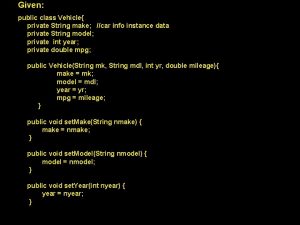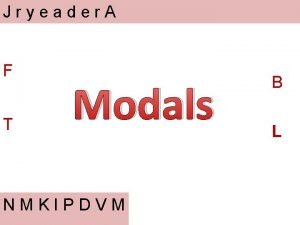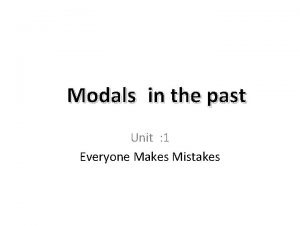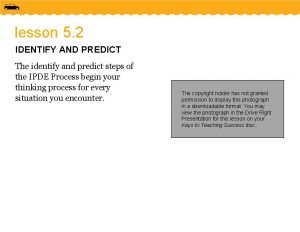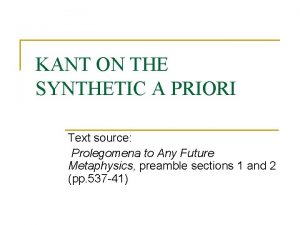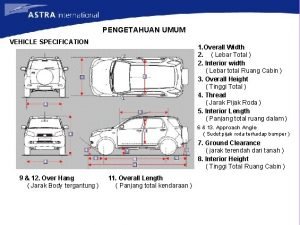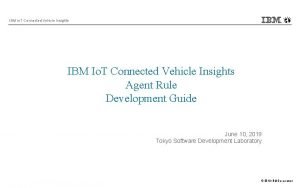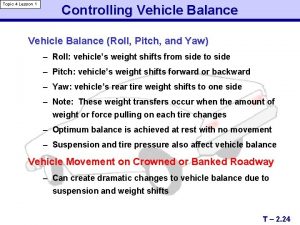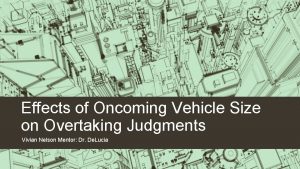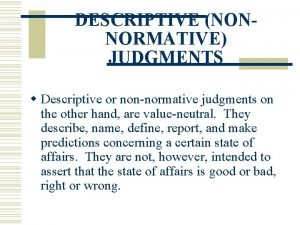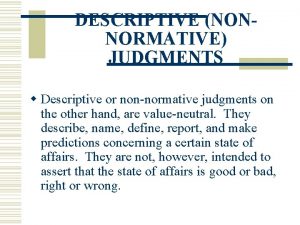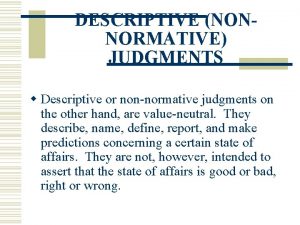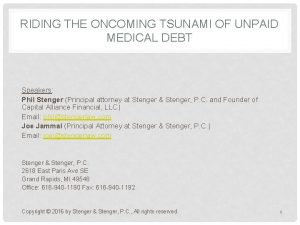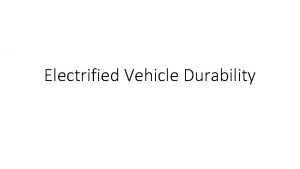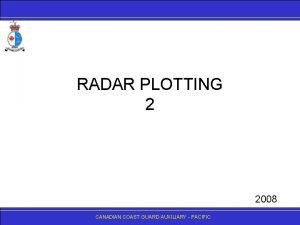EFFECTS OF ONCOMING VEHICLE SIZE ON OVERTAKING JUDGMENTS



















- Slides: 19

EFFECTS OF ONCOMING VEHICLE SIZE ON OVERTAKING JUDGMENTS Vivian R. Nelson, Samuel J. Levulis, & Patricia R. De. Lucia

Background • Overtaking -Risky event -Drivers must make judgements (Grey and Regan, 2005) • Levulis, S. J. , De. Lucia, P. R. , & Jupe, J. (2015)

Experiment 1 • Purpose: Examine whether overtaking judgments are influenced by size of an oncoming vehicle • Oncoming vehicles alternated between a motorcycle, a car, or a truck on a two-lane highway • Participants were told that they should pass lead car if they felt it was safe • Participants accepted more gaps in front of the motorcycle – Results supported overtaking judgments were influenced by size • The size of vehicle was confounded with the type of the vehicle A view of a scene.

Experiment 2 • Purpose: To tease apart the effects of vehicle size and type • Oncoming vehicles alternated between a small motorcycle, a large motorcycle, as well as a small truck and a large truck on a two-lane highway • Participants accepted more gaps when the oncoming vehicle was a small motorcycle or a small truck compared to the large motorcycle and truck – Size, but not vehicle type influenced overtaking judgments • An alternative explanation remained: Perceived Threat – Participants may have perceived a collision with a larger vehicle as more harmful

The Current Study Purpose • Examine whether overtaking judgments are influenced by the size of an oncoming vehicle when the actual threat of the oncoming vehicle is removed

Method Participants • Twenty-four college students (12 male, 12 female) • Age ranged from 19 to 51 years old (M = 24) (SD = 7. 1) • All held a driver’s license

Method Display • A STISIMTM driving simulator was used to depict a car-following scenario on a straight, three-lane, two-way highway • In each scene, vehicle in the oncoming lane varied in size (small motorcycle, small truck, large motorcycle, and large truck) • Auditory tone sounded 7 s after scene began A screen shot of a scene.

Method Procedure • Active Participants: • Given control of their vehicle when tone sounded • Instructed to pass if they felt they could do so before the oncoming vehicle reached the position in the road adjacent to where they would re-enter the right lane • Passive Participants • Steering and speed automatically controlled • Instructed to press one of two buttons to indicate decision A top down view of a practice scene. Note: the red line did not appear in the experiment; nor did yellow cab appear

Independent Variables Control Type • Active and passive Manipulations • Oncoming vehicle (e. g. : small & large motorcycle + small and large truck) • Distance of oncoming vehicle (1500 ft, 2000 ft) • Speed of oncoming vehicle (45, 55, and 65 mph) • Speed of participant's vehicle (30, 40, and 50 mph) Note: larger versions of these vehicles were produced

Dependent Variables • Percentage of accepted gaps • Percentage of false alarms • Sensitivity (d’) • Response bias (β)

Results Percentage of Accepted Gaps

Results Percentage of False Alarms

Results Sensitivity

Results Response Bias

Conclusions • Found the same effect of vehicle size as Levulis et al. (2015) – Even when the possibility of a head-on collision was removed • Suggest the effect is likely a perceptual issue (e. g. , smaller vehicles are perceived to be farther away while larger vehicles are perceived to be closer)

Implications Drivers use perceptual cues when driving • Size-arrival-effect (Delucia, 2013) – Smaller objects are perceived as being farther away and larger objects are perceived to be closer Development of an “overtaking assistant” • Concepts have been developed but are not commercially available Educate drivers to help prevent accidents

References De. Lucia, P. R. (2013). Effects of size on collision perception and implications for perceptual theory and transportation safety. Current Directions in Psychological Science, 22, 199 -204. Gray, R. , & Regan, D. M. (2005). Perceptual processes used by drivers during overtaking in a driving simulator. Human factors, 47, 394 -417. Levulis, S. J. , De. Lucia, P. R. , & Jupe, J. (2015). Effects of oncoming vehicle size on overtaking judgments. Accident Analysis & Prevention, 82, 163 -170.

Acknowledgements • REU Program • Dr. Delucia • Lab B 15 • TTU Staff This material is based upon work supported by the National Science Foundation under Grant No. 1559393

Thank You.
 Love unfailing overtaking my heart
Love unfailing overtaking my heart When does macbeth revisit the witches
When does macbeth revisit the witches Public class vehicle private string name
Public class vehicle private string name I wasn't or i didn't
I wasn't or i didn't Everyone make or makes
Everyone make or makes Past modals for hypothetical situations
Past modals for hypothetical situations What is the orderly visual search pattern
What is the orderly visual search pattern Synthetic a priori judgments
Synthetic a priori judgments Const int size =18 string *tbl2
Const int size =18 string *tbl2 Application of size separation
Application of size separation Overall width
Overall width Chapter 9 vehicle maintenance fluid service and recycling
Chapter 9 vehicle maintenance fluid service and recycling Common vehicle interface initiative
Common vehicle interface initiative Motor vehicle depreciation
Motor vehicle depreciation Ijara
Ijara Oht foup
Oht foup Ibm connected vehicle insights
Ibm connected vehicle insights Nfpa electric vehicle safety training
Nfpa electric vehicle safety training Vehicle balance definition
Vehicle balance definition Ricb bhutan
Ricb bhutan


